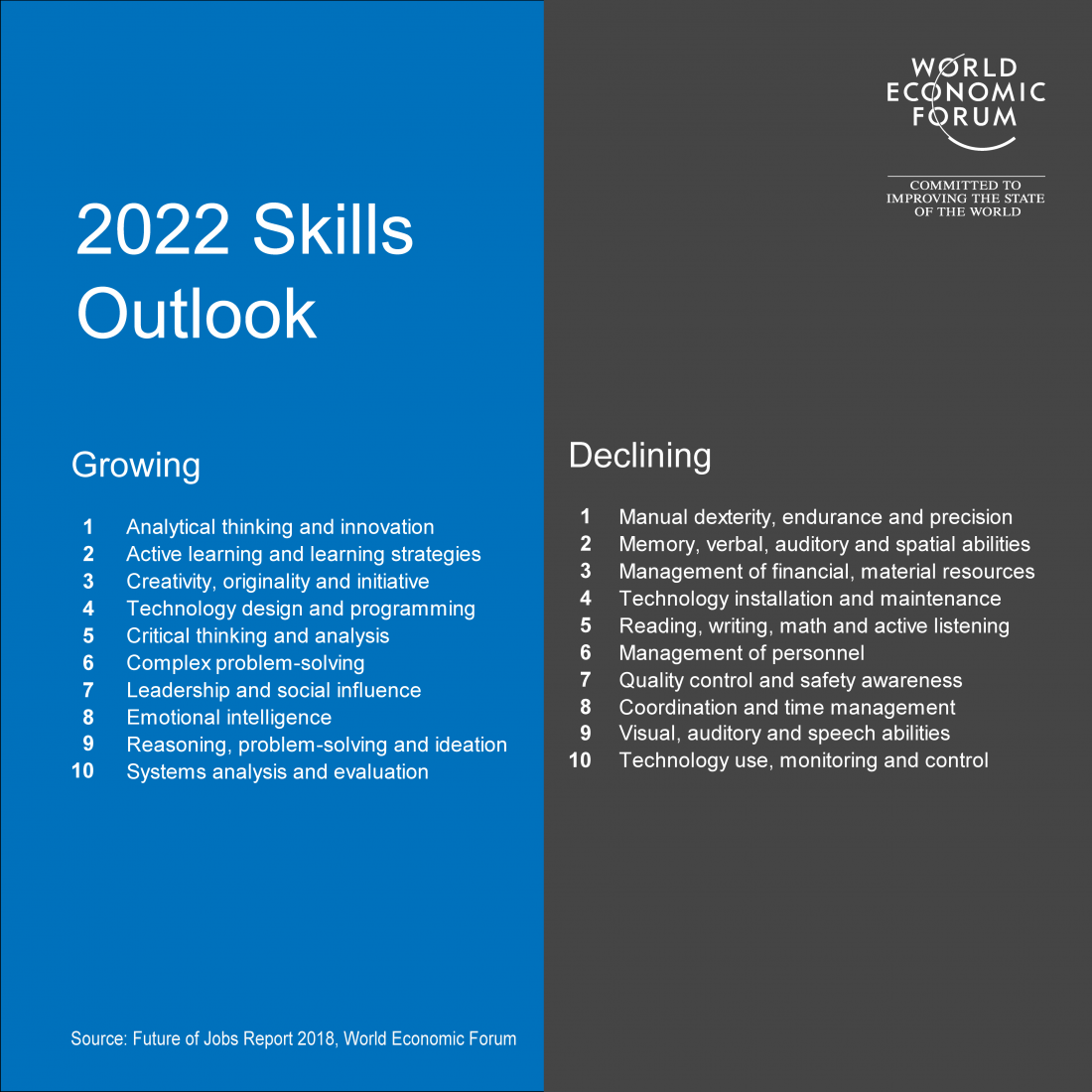Did you know that the World Economic Forum identifies five trends that everyone should know about? The Fourth Industrial Revolution has arrived, a tsunami of technology change. Embracing these five trends could prepare us for change. In this blog entry, we’ll explore one of the trends.
The Five Trends
Let’s review the trends, then reflect on them from an education perspective. The five trends the World Economic Forum identifies include the following:
- Automation, robotization and digitization are coming. The problem is, they look different depending on what industry you are in.
- Significant job disruption lies ahead. Displacing 75 million current jobs, machines and algorithms shift the division of work. That news aside, 133 million new job roles may emerge at the same time.
- Big shifts between who does what. Currently, humans do 71% of the work. In 2022, that will shift to 58%. What has changed the division of labor? Machines (robots) or algorithms.
- New work tasks push workers to learn new skills. Check out the chart below to see the shift.
- Embrace lifelong learning, or else. Each of those replaced will need at least 101 days of retraining and “upskilling.” If you plan to be working between now and 2022, you have some learning to do.
What do these trends mean for us as educators? Here are my initial thoughts on that final trend: embracing lifelong learning.
Make It Real
Do you know what irks me about reports like these? They never quite turn out the way you expect. As someone who’s leaning into middle age, I’m reminded of Ms. Nelda Crabknee. At fifty-five years of age, Nelda didn’t want to learn exciting new teaching strategies. She’d seen it all before, and retraining seemed like so much hocus pocus. Instead, she decided to retire in a year.
For folks like Nelda, I ask myself, “How can we make lifelong learning real?” When teachers succumb to human nature, learning new stuff may lead to retirement.
One way to make it real involves relying on strategies that work. Human beings have not changed all that much. One thing is certain: We will still have to consume content to learn it. How do you make lifelong learning real? You learn how to engage with that content in ways that align to how our brains are wired with proven strategies.
Proven Strategies
You can’t solve problems if reading presents you with an insurmountable challenge. A 2018 research study found primary students push themselves to read difficult books. As they get older, that push weakens. Can you imagine them as adults? “Wait, we have to read that technical text on stationary robot operation?”
“Over eighty-five percent of the reading and writing we do as adults is nonfiction,” says Tony Stead. Consider that students will need to devour nonfiction writing to be future ready. There are four building blocks to improving reading comprehension and engagement. These building blocks assist students in ways that will not change in the future. Those blocks include:
- Staying engaged. Working through complicated texts, manuals, and video tutorials can be tough. Students need to learn to look for different clues and ideas in what they read.
- Improving literacy. In studying manuals, texts, and websites, students may skip words they don’t know. Instead, they need to be able to figure out what they mean.
- Enhancing comprehension. Students must be able to do more than decode text. They have to understand what they are reading.
And one final building block that ties into the World Economic Forum’s trend number five. That block is being able to learn on their own or in group. Many of our students struggle alone, trying to figure out how to learn on their own. Yet learning is social. Knowing how to learn as part of a team prepares them for the future. Let’s take a look at some strategies that may help our children get there.
Strategy #1: Summarization
“Your daughter has trouble with summarization,” the teacher told us. She said it in a much kinder tone and used my daughter’s name. As for myself, I was a bit at a loss. I had noticed my daughter tended to repeat everything that had happened.
Summarization involves identifying the main idea and most important facts. For me, outlining text was a great way to capture those ideas. I switched to concept maps in high school when a teacher modeled it for me. It became my go-to strategy.
If you know John Hattie’s work, you know that summarization has an effect size of .79. Since the hinge point for student growth is .40, which is a year’s normal growth, .79 is significant. It’s almost two year’s of a student’s normal growth in half the time. How do you teach summarization? There are many strategies. One of my concerns, as Tony Stead points out in his book Is That a Fact?, remains the focus on storytelling. I assure you that the work of tomorrow will require comprehension of nonfiction.
For students, summarizing can be straightforward. They can learn to circle the main idea, underline details, and use sentence starters to summarize.
Sentence Starters
Some sentence starters you can introduce students to include the following by category:
Summarizing a Process might involve one of these:
- The first step to solving___is to…
- When solving for _, first __, then ___, and finally .
- To solve [name of a problem], first [describe the first step in a solution]. Then [describe the second step and so on].
- Follow these steps to….
Summarizing and Interpreting Visuals can have students saying:
- The image/video shows…
- This table or drawing suggests…
- The graph or picture shows….
- After looking at this image, I now understand….
Summarizing Ideas in a Nonfiction Text may begin in one of these ways:
- The main point is…
- One important detail is…
- This page or paragraph is about…
- Today, we learned about a new word/idea/concept….
These are some powerful ways to get students engaging with text as they identify key content. Think of the many ways students can use technology to do this. Explore paper slide videos as one way to do this.
In future blog entries, we’ll explore other strategies in the context of reciprocal teaching.
Practice Makes Perfect, or at Least Better
Want to prepare yourself for lifelong learning? Learn to read and comprehend technical texts. Practice working with others to summarize in an effective way. Use strategies like summarization with your students to speed their annual academic growth. Have fun and keep pushing!




